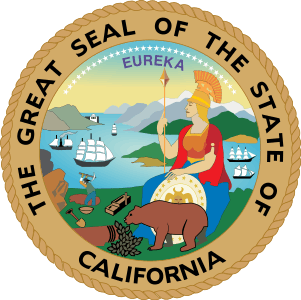Yosemite National Park
Yosemite National Park (/joʊˈsɛmɪti/ yoh-SEM-i-tee)[4] is an American national park located in the western Sierra Nevada of Central California,[5][6] bounded on the southeast by Sierra National Forest and on the northwest by Stanislaus National Forest. The park is managed by the National Park Service and covers an area of 748,436 acres (1,169 sq mi; 3,029 km2)[2] and sits in four counties: centered in Tuolumne and Mariposa, extending north and east to Mono and south to Madera County. Designated a World Heritage site in 1984, Yosemite is internationally recognized for its granite cliffs, waterfalls, clear streams, giant sequoia groves, lakes, mountains, meadows, glaciers, and biological diversity.[7] Almost 95% of the park is designated wilderness.[8]
| Yosemite National Park | |
|---|---|
IUCN category II (national park) | |
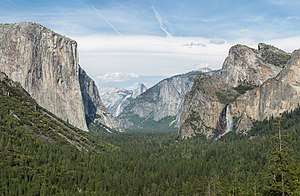 | |
 Yosemite National Park Location in California  Yosemite National Park Location in the United States | |
| Location | Tuolumne, Mariposa, Mono, & Madera counties, California, United States |
| Nearest city | Mariposa, California |
| Coordinates | 37°51′N 119°33′W[1] |
| Area | 748,436 acres (3,028.81 km2)[2] |
| Established | October 1, 1890 |
| Visitors | 4,422,861 (in 2019)[3] |
| Governing body | National Park Service |
| Website | Yosemite National Park |
| Criteria | Natural: vii, viii |
| Reference | 308 |
| Inscription | 1984 (8th session) |
On average, about four million people visit Yosemite each year,[9] and most spend the majority of their time in the seven square miles (18 km2) of Yosemite Valley.[7] The park set a visitation record in 2016, surpassing five million visitors for the first time in its history.[10] Yosemite was central to the development of the national park idea. Galen Clark and others lobbied to protect Yosemite Valley from development, ultimately leading to President Abraham Lincoln's signing the Yosemite Grant in 1864. John Muir led a successful movement to have Congress establish a larger national park by 1890, one which encompassed the valley and its surrounding mountains and forests, paving the way for the National Park System.[11]
Yosemite is one of the largest and least fragmented habitat blocks in the Sierra Nevada, and the park supports a diversity of plants and animals. The park has an elevation range from 2,127 to 13,114 feet (648 to 3,997 m) and contains five major vegetation zones: chaparral and oak woodland, lower montane forest, upper montane forest, subalpine zone, and alpine. Of California's 7,000 plant species, about 50% occur in the Sierra Nevada and more than 20% are within Yosemite. The park contains suitable habitat for more than 160 rare plants, with rare local geologic formations and unique soils characterizing the restricted ranges many of these plants occupy.[7]
The geology of the Yosemite area is characterized by granitic rocks and remnants of older rock. About 10 million years ago, the Sierra Nevada was uplifted and then tilted to form its relatively gentle western slopes and the more dramatic eastern slopes. The uplift increased the steepness of stream and river beds, resulting in the formation of deep, narrow canyons. About one million years ago, snow and ice accumulated, forming glaciers at the higher alpine meadows that moved down the river valleys. Ice thickness in Yosemite Valley may have reached 4,000 feet (1,200 m) during the early glacial episode. The downslope movement of the ice masses cut and sculpted the U-shaped valley that attracts so many visitors to its scenic vistas today.[7]
The name "Yosemite" (meaning "killer" in Miwok) originally referred to the name of a tribe which was driven out of the area (and possibly annihilated) by the Mariposa Battalion. Previously, the area had been called "Ahwahnee" ("big mouth") by indigenous people.[12]
History
Ahwahneechee and the Mariposa Wars


Yosemite Valley has been inhabited for nearly 3,000 years, although humans may have first visited the area as long as 8,000 to 10,000 years ago.[13] The indigenous natives called themselves the Ahwahnechee, meaning "dwellers in Ahwahnee".[14] They are related to the Northern Paiute and Mono tribes. Many tribes visited the area to trade, including nearby Central Sierra Miwoks, who lived along the drainage area of the Tuolumne and Stanislaus Rivers.[15] A major trading route went over Mono Pass and through Bloody Canyon to Mono Lake, just to the east of the Yosemite area. Vegetation and game in the region were similar to that present today; acorns were a staple to their diet, as well as other seeds and plants, salmon and deer.[16]
The California Gold Rush in the mid-19th century dramatically increased travel by European-Americans in the area, causing competition for resources between the regional Paiute and Miwok and the miners and hangers on. In 1851 as part of the Mariposa Wars intended to suppress Native American resistance, United States Army Major Jim Savage led the Mariposa Battalion into the west end of Yosemite Valley. He was pursuing forces of around 200 Ahwahneechee led by Chief Tenaya.[17]
Accounts from this battalion were the first well-documented reports of ethnic Europeans entering Yosemite Valley. Attached to Savage's unit was Dr. Lafayette Bunnell, the company physician, who later wrote about his awestruck impressions of the valley in The Discovery of the Yosemite. Bunnell is credited with naming Yosemite Valley, based on his interviews with Chief Tenaya. Bunnell wrote that Chief Tenaya was the founder of the Ah-wah-nee colony.[18] The Miwok, a neighboring tribe, and most white settlers considered the Ahwahneechee to be especially violent because of their frequent territorial disputes. The Miwok term for the Pai-Ute band was yohhe'meti, meaning "they are killers".[19][20] Correspondence and articles written by members of the battalion helped to popularize the natural wonders of the Yosemite Valley and the surrounding area. Chief Tenaya and his Ahwahneechee were eventually captured and their village burned; they were removed to a reservation near Fresno, California. The chief and some others were later allowed to return to Yosemite Valley. In the spring of 1852 they attacked a group of eight gold miners, and then moved east to flee law enforcement.[21] Near Mono Lake, they took refuge with the nearby Mono tribe of Paiute. They stole horses from their hosts and moved away, but the Mono Paiutes tracked down and killed many of the Ahwahneechee, including Chief Tenaya. The Mono Paiute took the survivors as captives back to Mono Lake and absorbed them into the Mono Lake Paiute tribe.
After these wars, a number of Native Americans continued to live within the boundaries of Yosemite. A number of Indians supported the growing tourism industry by working as laborers or maids. Later, Indians became part of the tourism industry itself by selling baskets or performing for tourists.[22] A reconstructed "Indian Village of Ahwahnee" has been erected behind the Yosemite Museum, located next to the Yosemite Valley Visitor Center.
Early tourists

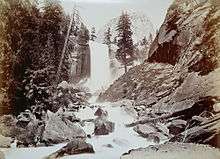
In 1855, entrepreneur James Mason Hutchings, artist Thomas Ayres and two others were the first to tour the area.[17] Hutchings and Ayres were responsible for much of the earliest publicity about Yosemite, writing articles and special magazine issues about the Valley.[23] Ayres' style in art was highly detailed with exaggerated angularity. His works and written accounts were distributed nationally, and an art exhibition of his drawings was held in New York City. Hutchings' publicity efforts between 1855 and 1860 led to an increase in tourism to Yosemite.[24]
Wawona was an Indian encampment in what is now the southwestern part of the park. Settler Galen Clark discovered the Mariposa Grove of giant sequoia in Wawona in 1857. He had simple lodgings built, and roads to the area. In 1879, the Wawona Hotel was built to serve tourists visiting Mariposa Grove. As tourism increased, so did the number of trails and hotels developed by people intending to build on the trade.
The Wawona Tree, also known as the Tunnel Tree, was a famous giant sequoia that stood in the Mariposa Grove. It was 227 feet (69 m) tall, and was 90 ft (27 m) in circumference. When a carriage-wide tunnel was cut through the tree in 1881, it became even more popular as a tourist photo attraction. Everything from horse-drawn carriages in the late 19th century, to automobiles in the first part of the 20th century, traveled the road which passed through that tree. The tree was permanently weakened by the tunnel, and the Wawona Tree fell in 1969 under a heavy load of snow. It was estimated to have been 2,300 years old. It is unclear how much longer it may have lived if it had not been damaged.
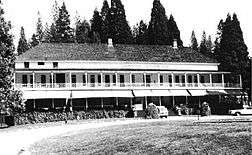

Yosemite's first concession was established in 1884 when John Degnan and his wife established a bakery and store.[25] In 1916, the National Park Service granted a 20-year concession to the Desmond Park Service Company. It bought out or built hotels, stores, camps, a dairy, a garage, and other park services.[26] Desmond changed its name to the Yosemite National Park Company in December 1917 and was reorganized in 1920.[27]
The Curry Company had been started in 1899 by David and Jennie Curry to provide concessions in the park. They also founded Camp Curry, formerly known as Half Dome Village, now restored back to Curry Village.[28] The Currys lobbied reluctant park supervisors to allow expansion of concession operations and development in the area.
Administrators in the National Park Service felt that limiting the number of concessionaires in each national park would be more financially sound. The Curry Company and its rival, the Yosemite National Park Company, were forced to merge in 1925 to form the Yosemite Park & Curry Company (YP&CC).[29] The company built the Ahwahnee Hotel in 1927.
Yosemite Grant

Concerned by the effects of commercial interests, prominent citizens including Galen Clark and Senator John Conness advocated for protection of the area. A park bill was prepared with the assistance of the General Land Office in the Interior Department.[30] The bill passed both houses of the 38th United States Congress, and was signed by President Abraham Lincoln on June 30, 1864, creating the Yosemite Grant.[31][32] This is the first instance of park land being set aside specifically for preservation and public use by action of the U.S. federal government, and set a precedent for the 1872 creation of Yellowstone as the first national park.[11] Yosemite Valley and the Mariposa Grove were ceded to California as a state park, and a board of commissioners was proclaimed two years later.
Galen Clark was appointed by the commission as the Grant's first guardian, but neither Clark nor the commissioners had the authority to evict homesteaders (which included Hutchings).[31] The issue was not settled until 1872 when the homesteader land holdings were invalidated by the U.S. Supreme Court.[33] Clark and the reigning commissioners were ousted in 1880, this dispute also reaching the Supreme Court in 1880.[34] The two Supreme Court decisions affecting management of the Yosemite Grant are considered important precedents in land management law.[35] Hutchings became the new park guardian.[36]
Access to the park by tourists improved in the early years of the park, and conditions in the Valley were made more hospitable. Tourism significantly increased after the First Transcontinental Railroad was completed in 1869, but the long horseback ride to reach the area was a deterrent.[31] Three stagecoach roads were built in the mid-1870s to provide better access for the growing number of visitors to Yosemite Valley.
John Muir was a Scottish-born American naturalist and explorer. It was because of Muir that many National Parks were left untouched, such as Yosemite Valley National Park. One of the most significant camping trips Muir took was in 1903 with then president Theodore Roosevelt. This trip persuaded Roosevelt to return "Yosemite Valley and Mariposa Grove to federal protection as part of Yosemite National Park".[37]
Muir wrote articles popularizing the area and increasing scientific interest in it. Muir was one of the first to theorize that the major landforms in Yosemite Valley were created by large alpine glaciers, bucking established scientists such as Josiah Whitney, who regarded Muir as an amateur.[36] Muir wrote scientific papers on the area's biology. Landscape architect Frederick Law Olmsted emphasized the importance of conservation of Yosemite Valley.
Increased protection efforts

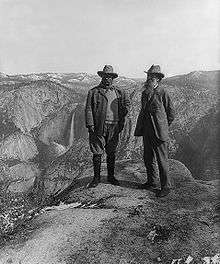
Overgrazing of meadows (especially by sheep), logging of giant sequoia, and other damage caused Muir to become an advocate for further protection. Muir convinced prominent guests of the importance of putting the area under federal protection; one such guest was Robert Underwood Johnson, editor of Century Magazine. Muir and Johnson lobbied Congress for the Act that created Yosemite National Park on October 1, 1890.[38] The State of California, however, retained control of Yosemite Valley and Mariposa Grove. Muir also helped persuade local officials to virtually eliminate grazing from the Yosemite high country.
The newly created national park came under the jurisdiction of the United States Army's Troop I of the 4th Cavalry on May 19, 1891, which set up camp in Wawona with Captain Abram Epperson Wood as acting superintendent.[38] By the late 1890s, sheep grazing was no longer a problem, and the Army made other improvements. The cavalry could not intervene to ease the worsening condition of Yosemite Valley and Mariposa Grove. The cavalry left another legacy in the park, the ranger hat. From 1899 to 1913, cavalry regiments of the Western Department, including the all Black 9th Cavalry (known as the "Buffalo Soldiers") and the 1st Cavalry, stationed two troops at Yosemite and brought with them the trooper's campaign hat with its distinctive Montana Peak we recognize today as the "ranger hat". This peak had been formed into the trooper's stetson by veterans of the 1898 Spanish–American War to better shed tropical rain.

Muir and his Sierra Club continued to lobby the government and influential people for the creation of a unified Yosemite National Park. In May 1903, President Theodore Roosevelt camped with Muir near Glacier Point for three days. On that trip, Muir convinced Roosevelt to take control of Yosemite Valley and Mariposa Grove away from California and return it to the federal government. In 1906, Roosevelt signed a bill that did precisely that.
National Park Service
The National Park Service was formed in 1916, and Yosemite was transferred to that agency's jurisdiction. Tuolumne Meadows Lodge, Tioga Pass Road, and campgrounds at Tenaya and Merced lakes were also completed in 1916.[39] Automobiles started to enter the park in ever-increasing numbers following the construction of all-weather highways to the park. The Yosemite Museum was founded in 1926 through the efforts of Ansel Franklin Hall.[40]In the 1920s, the museum featured Native Americans practicing traditional crafts, and many of the Sierra Miwok continued to live in Yosemite Valley until they were evicted from Yosemite in the 1960s.[41]
In 1903, a dam in the northern portion of the park was proposed. Located in the Hetch Hetchy Valley, its purpose was to provide water and hydroelectric power to San Francisco. Muir and the Sierra Club opposed the project, while others, including Gifford Pinchot, supported it.[42] In 1913, the U.S. Congress authorized the O'Shaughnessy Dam through passage of the Raker Act.[43]
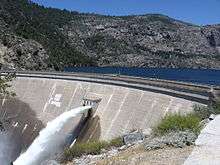
In the late 1920s a bid for Yosemite for the 1932 Winter Olympics was put forward. Ultimately, the 1932 Winter Olympics were awarded to Lake Placid, New York.[44] In 1937, conservationist Rosalie Edge, head of the Emergency Conservation Committee (ECC), successfully lobbied Congress to purchase about 8,000 acres of old-growth sugar pines on the perimeter of Yosemite National Park that were to be logged.[45]
More recently, preservationists persuaded Congress to designate 677,600 acres (274,200 ha), or about 89% of the park, as the Yosemite Wilderness—a highly protected wilderness area.[46] The Park Service has reduced artificial inducements to visit the park, such as the Firefall, in which red-hot embers were pushed off a cliff near Glacier Point at night. Traffic congestion in Yosemite Valley during the summer months has become a concern. Two electric buses commenced service in September 1995. The buses are quiet and do not emit pollutants. Eventually, all the buses in Yosemite will be electric.[47]
In 2016, The Trust for Public Land purchased Ackerson Meadow, a 400-acre tract on the western edge of Yosemite National Park, for $2.3 million in order to preserve habitat and protect the area from development. Ackerson Meadow was originally included in the proposed 1890 park boundary but never acquired by the federal government. On September 7, 2016, the National Park Service accepted the donation of the land, making the meadow the largest addition to Yosemite since 1949.[48]
Geography
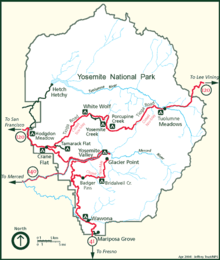
Yosemite National Park is located in the central Sierra Nevada of California. Three wilderness areas are adjacent to Yosemite: the Ansel Adams Wilderness to the southeast, the Hoover Wilderness to the northeast, and the Emigrant Wilderness to the north.
The 1,189 sq mi (3,080 km2) park is roughly the size of the U.S. state of Rhode Island and contains thousands of lakes and ponds, 1,600 miles (2,600 km) of streams, 800 miles (1,300 km) of hiking trails, and 350 miles (560 km) of roads.[49] Two federally designated Wild and Scenic Rivers, the Merced and the Tuolumne, begin within Yosemite's borders and flow westward through the Sierra foothills, into the Central Valley of California. On average, about 4 million people visit the park each year,[9] with most visitor use concentrated in the seven-square-mile (18 km2) area of Yosemite Valley.[49]
Rocks and erosion
Almost all of the landforms in the Yosemite area are cut from the granitic rock of the Sierra Nevada Batholith (a batholith is a large mass of intrusive igneous rock that formed deep below the surface).[50] About 5% of the park's landforms (mostly in its eastern margin near Mount Dana) are metamorphosed volcanic and sedimentary rocks.[51] These rocks are called roof pendants because they were once the roof of the underlying granitic rock.[52]
Erosion acting upon different types of uplift-created joint and fracture systems is responsible for creating the valleys, canyons, domes, and other features we see today. These joints and fracture systems do not move, and are therefore not faults.[53] Spacing between joints is controlled by the amount of silica in the granite and granodiorite rocks; more silica tends to create a more resistant rock, resulting in larger spaces between joints and fractures.[54]
Pillars and columns, such as Washington Column and Lost Arrow, are created by cross joints. Erosion acting on master joints is responsible for creating valleys and later canyons.[54] The single most erosive force over the last few million years has been large alpine glaciers, which have turned the previously V-shaped river-cut valleys into U-shaped glacial-cut canyons (such as Yosemite Valley and Hetch Hetchy Valley). Exfoliation (caused by the tendency of crystals in plutonic rocks to expand at the surface) acting on granitic rock with widely spaced joints is responsible for creating domes such as Half Dome and North Dome and inset arches like Royal Arches.[55]
Popular features
Yosemite Valley represents only one percent of the park area, but this is where most visitors arrive and stay. The Tunnel View is the first view of the Valley for many visitors and is extensively photographed. El Capitan, a prominent granite cliff that looms over Yosemite Valley, is one of the most popular rock climbing destinations in the world because of its diverse range of climbing routes in addition to its year-round accessibility. Granite domes such as Sentinel Dome and Half Dome rise 3,000 and 4,800 feet (910 and 1,460 m), respectively, above the valley floor. In the park are many domes.
The high country of Yosemite contains beautiful areas such as Tuolumne Meadows, Dana Meadows, the Clark Range, the Cathedral Range, and the Kuna Crest. The Sierra crest and the Pacific Crest Trail run through Yosemite, with peaks of red metamorphic rock, such as Mount Dana and Mount Gibbs, and granite peaks, such as Mount Conness. Mount Lyell is the highest point in the park, standing at 13,120 feet (4,000 m). The Lyell Glacier is the largest glacier in Yosemite National Park and is one of the few remaining in the Sierra Nevada today.
The park has three groves of ancient giant sequoia (Sequoiadendron giganteum) trees; the Mariposa Grove (200 trees), the Tuolumne Grove (25 trees), and the Merced Grove (20 trees).[56] This species grows larger in volume than any other and is one of the tallest and longest-lived.[57]
Water and ice

The Tuolumne and Merced River systems originate along the crest of the Sierra Nevada in the park and have carved river canyons 3,000 to 4,000 feet (910 to 1,220 m) deep. The Tuolumne River drains the entire northern portion of the park, an area of approximately 680 square miles (1,800 km2). The Merced River begins in the park's southern peaks, primarily the Cathedral and Clark Ranges, and drains an area of approximately 511 square miles (1,320 km2).[58]
Hydrologic processes, including glaciation, flooding, and fluvial geomorphic response, have been fundamental in creating landforms in the park.[58] The park also contains approximately 3,200 lakes (greater than 100 m2), two reservoirs, and 1,700 miles (2,700 km) of streams, all of which help form these two large watersheds.[59] Wetlands in Yosemite occur in valley bottoms throughout the park, and are often hydrologically linked to nearby lakes and rivers through seasonal flooding and groundwater movement. Meadow habitats, distributed at elevations from 3,000 to 11,000 feet (910 to 3,350 m) in the park, are generally wetlands, as are the riparian habitats found on the banks of Yosemite's numerous streams and rivers.[60]
Yosemite is famous for its high concentration of waterfalls in a small area. Numerous sheer drops, glacial steps and hanging valleys in the park provide many places for waterfalls to exist, especially during April, May, and June (the snowmelt season). Located in Yosemite Valley, the Yosemite Falls is the highest in North America at 2,425 feet (739 m). Also in Yosemite Valley is the much lower volume Ribbon Falls, which has the highest single vertical drop, 1,612 feet (491 m).[57] Perhaps the most prominent of the Yosemite Valley waterfalls is Bridalveil Fall, which is the waterfall seen from the Tunnel View viewpoint at the east end of the Wawona Tunnel. Wapama Falls in Hetch Hetchy Valley is another notable waterfall. Hundreds of ephemeral waterfalls also exist in the park.
All glaciers in the park are relatively small glaciers that occupy areas that are in almost permanent shade, such as north- and northeast-facing cirques. Lyell Glacier is the largest glacier in Yosemite (the Palisades Glaciers are the largest in the Sierra Nevada) and covers 160 acres (65 ha).[61] None of the Yosemite glaciers are a remnant of the much, much larger Ice Age alpine glaciers responsible for sculpting the Yosemite landscape. Instead, they were formed during one of the neoglacial episodes that have occurred since the thawing of the Ice Age (such as the Little Ice Age).[56] Climate change has reduced the number and size of glaciers around the world. Many Yosemite glaciers, including Merced Glacier, which was discovered by John Muir in 1871 and bolstered his glacial origins theory of the Yosemite area, have disappeared and most of the others have lost up to 75% of their surface area.[61]
Climate
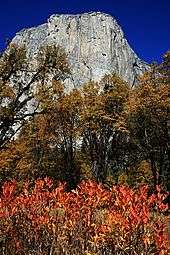
Yosemite has a Mediterranean climate (Köppen climate classification Csa), meaning most precipitation falls during the mild winter, and the other seasons are nearly dry (less than 3% of precipitation falls during the long, hot summers).[62] Because of orographic lift, precipitation increases with elevation up to 8,000 feet (2,400 m) where it slowly decreases to the crest. Precipitation amounts vary from 36 inches (910 mm) at 4,000 feet (1,200 m) elevation to 50 inches (1,300 mm) at 8,600 feet (2,600 m). Snow does not typically persist on the ground until November in the high country. It accumulates all winter and into March or early April.[63]
Mean daily temperatures range from 25 °F (−4 °C) to 53 °F (12 °C) at Tuolumne Meadows at 8,600 feet (2,600 m). At the Wawona Entrance (elevation 5,130 feet or 1,560 metres), mean daily temperature ranges from 36 to 67 °F (2 to 19 °C). At the lower elevations below 5,000 feet (1,500 m), temperatures are hotter; the mean daily high temperature at Yosemite Valley (elevation 3,966 feet or 1,209 metres) varies from 46 to 90 °F (8 to 32 °C). At elevations above 8,000 feet (2,400 m), the hot, dry summer temperatures are moderated by frequent summer thunderstorms, along with snow that can persist into July. The combination of dry vegetation, low relative humidity, and thunderstorms results in frequent lightning-caused fires as well.[63]
At the park headquarters, with an elevation of 3,966 feet (1,209 m), January averages 38.2 °F (3.4 °C), while July averages 73.0 °F (22.8 °C), though in summer the nights are much cooler than the hot days.[64] There are an average of 39.5 days with highs of 90 °F (32 °C) or higher and an average of 97.9 nights with freezing temperatures.[64] Freezing temperatures have been recorded in every month of the year. The record high temperature was 115 °F (46 °C) on July 20, 1915, while the record low temperature was −6 °F (−21 °C) on January 2, 1924 and on January 21, 1937.[64][65] Average annual precipitation is nearly 37 inches (940 mm), falling on 65 days. The wettest year was 1983 with 68.94 inches (1,751 mm) and the driest year was 1976 with 14.84 inches (377 mm).[65] The most precipitation in one month was 29.61 inches (752 mm) in December 1955 and the most in one day was 6.92 inches (176 mm) on December 23, 1955.[65] Average annual snowfall is 65.6 inches (1.67 m). The snowiest year was 1967 with 154.9 inches (3.93 m). The most snow in one month was 140.8 inches (3.58 m) in January 1993.[65]
| Climate data for Yosemite Park Headquarters, elev. 3,966 feet (1,209 m) | |||||||||||||
|---|---|---|---|---|---|---|---|---|---|---|---|---|---|
| Month | Jan | Feb | Mar | Apr | May | Jun | Jul | Aug | Sep | Oct | Nov | Dec | Year |
| Record high °F (°C) | 72 (22) |
82 (28) |
90 (32) |
96 (36) |
99 (37) |
103 (39) |
115 (46) |
110 (43) |
108 (42) |
98 (37) |
86 (30) |
73 (23) |
115 (46) |
| Average high °F (°C) | 47.2 (8.4) |
53.1 (11.7) |
58.7 (14.8) |
65.9 (18.8) |
72.8 (22.7) |
81.4 (27.4) |
89.9 (32.2) |
89.5 (31.9) |
83.5 (28.6) |
73.5 (23.1) |
57.7 (14.3) |
47.5 (8.6) |
68.3 (20.2) |
| Average low °F (°C) | 25.6 (−3.6) |
28.1 (−2.2) |
31.0 (−0.6) |
35.9 (2.2) |
41.6 (5.3) |
47.3 (8.5) |
53.2 (11.8) |
52.0 (11.1) |
46.7 (8.2) |
38.3 (3.5) |
30.2 (−1.0) |
26.2 (−3.2) |
38.0 (3.3) |
| Record low °F (°C) | −6 (−21) |
1 (−17) |
9 (−13) |
12 (−11) |
15 (−9) |
14 (−10) |
32 (0) |
32 (0) |
24 (−4) |
19 (−7) |
10 (−12) |
−1 (−18) |
−6 (−21) |
| Average precipitation inches (mm) | 6.51 (165) |
6.17 (157) |
5.39 (137) |
3.04 (77) |
1.47 (37) |
0.70 (18) |
0.31 (7.9) |
0.20 (5.1) |
0.66 (17) |
1.91 (49) |
3.93 (100) |
5.97 (152) |
36.26 (922) |
| Average snowfall inches (cm) | 16.2 (41) |
14.6 (37) |
12.9 (33) |
5.1 (13) |
0.2 (0.51) |
0 (0) |
0 (0) |
0 (0) |
0 (0) |
0.2 (0.51) |
3.6 (9.1) |
12.5 (32) |
65.6 (167) |
| Average precipitation days (≥ 0.01 in) | 9 | 9 | 10 | 7 | 5 | 3 | 1 | 1 | 2 | 4 | 6 | 8 | 65 |
| Mean monthly sunshine hours | 186.0 | 196.0 | 279.0 | 300.0 | 341.0 | 333.0 | 372.0 | 341.0 | 300.0 | 279.0 | 210.0 | 186.0 | 3,323 |
| Mean daily sunshine hours | 6.0 | 7.0 | 9.0 | 10.0 | 11.0 | 11.0 | 12.0 | 11.0 | 10.0 | 9.0 | 7.0 | 6.0 | 9.1 |
| Percent possible sunshine | 60 | 64 | 75 | 77 | 79 | 73 | 86 | 79 | 83 | 82 | 70 | 60 | 74 |
| Source 1: WRCC (1905–2012)[65] | |||||||||||||
| Source 2: Weather Atlas (sunshine data)[66] | |||||||||||||
| Climate data for Yosemite National Park | |||||||||||||
|---|---|---|---|---|---|---|---|---|---|---|---|---|---|
| Month | Jan | Feb | Mar | Apr | May | Jun | Jul | Aug | Sep | Oct | Nov | Dec | Year |
| Mean daily daylight hours | 10.0 | 11.0 | 12.0 | 13.0 | 14.0 | 15.0 | 14.0 | 14.0 | 12.0 | 11.0 | 10.0 | 10.0 | 12.2 |
| Average Ultraviolet index | 2 | 4 | 6 | 7 | 9 | 10 | 11 | 10 | 8 | 5 | 3 | 2 | 6.4 |
| Source: Weather Atlas[66] | |||||||||||||
Geology
Tectonic and volcanic activity
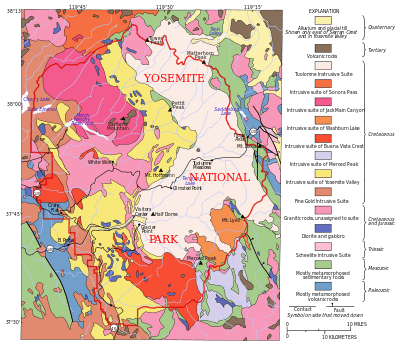
The area of the park was astride a passive continental margin during the Precambrian and early Paleozoic.[67] Sediment was derived from continental sources and was deposited in shallow water. These rocks have since been metamorphosed.
Heat generated from the Farallon Plate subducting below the North American Plate led to the creation of an island arc of volcanoes on the west coast of proto-North America between the late Devonian and Permian periods.[67] Later volcanism in the Jurassic intruded and covered these rocks in what may have been magmatic activity associated with the early stages of the creation of the Sierra Nevada Batholith. 95% of these rocks were eventually removed by uplifted-accelerated erosion.
The first phase of regional plutonism started 210 million years ago in the late Triassic and continued throughout the Jurassic to about 150 million years before present (BP).[50] Around the same time, the Nevadan orogeny built the Nevadan mountain range (also called the Ancestral Sierra Nevada) to a height of 15,000 feet (4,600 m). This was directly part of the creation of the Sierra Nevada Batholith, and the resulting rocks were mostly granitic in composition and emplaced about 6 miles (9.7 km) below the surface.[68] The second major pluton emplacement phase lasted from about 120 million to 80 million years ago during the Cretaceous.[50] This was part of the Sevier orogeny.
Starting 20 million years ago (in the Cenozoic) and lasting until 5 million years ago, a now-extinct extension of Cascade Range volcanoes erupted, bringing large amounts of igneous material in the area. These igneous deposits blanketed the region north of the Yosemite region. Volcanic activity persisted past 5 million years BP east of the current park borders in the Mono Lake and Long Valley areas.
Uplift and erosion
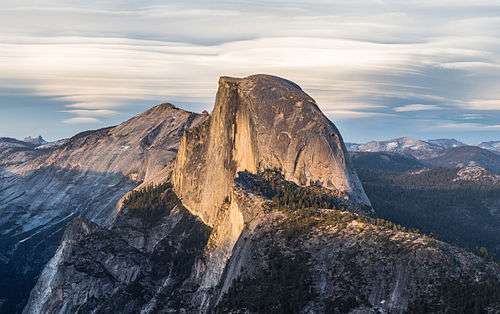
Starting 10 million years ago, vertical movement along the Sierra fault started to uplift the Sierra Nevada. Subsequent tilting of the Sierra block and the resulting accelerated uplift of the Sierra Nevada increased the gradient of western-flowing streams.[69] The streams consequently ran faster and thus cut their valleys more quickly. Additional uplift occurred when major faults developed to the east, especially the creation of Owens Valley from Basin and Range-associated extensional forces. Uplift of the Sierra accelerated again about two million years ago during the Pleistocene.
The uplifting and increased erosion exposed granitic rocks in the area to surface pressures, resulting in exfoliation (responsible for the rounded shape of the many domes in the park) and mass wasting following the numerous fracture joint planes (cracks; especially vertical ones) in the now solidified plutons.[55] Pleistocene glaciers further accelerated this process and the larger ones transported the resulting talus and till from valley floors.
Numerous vertical joint planes controlled where and how fast erosion took place. Most of these long, linear and very deep cracks trend northeast or northwest and form parallel, often regularly spaced sets. They were created by uplift-associated pressure release and by the unloading of overlying rock via erosion.
Sculpting by glaciers
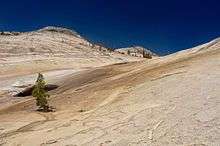
A series of glaciations further modified the region starting about 2 to 3 million years ago and ending sometime around 10,000 BP. At least four major glaciations have occurred in the Sierra Nevada, locally called the Sherwin (also called the pre-Tahoe), Tahoe, Tenaya, and Tioga.[69] The Sherwin glaciers were the largest, filling Yosemite and other valleys, while later stages produced much smaller glaciers. A Sherwin-age glacier was almost surely responsible for the major excavation and shaping of Yosemite Valley and other canyons in the area.
Glacial systems reached depths of up to 4,000 feet (1,200 m) and left their marks in the Yosemite area. The longest glacier in the Yosemite area ran down the Grand Canyon of the Tuolumne River for 60 miles (97 km), passing well beyond Hetch Hetchy Valley. Merced Glacier flowed out of Yosemite Valley and into the Merced River Gorge. Lee Vining Glacier carved Lee Vining Canyon and emptied into Lake Russel (the much-enlarged ice age version of Mono Lake). Only the highest peaks, such as Mount Dana and Mount Conness, were not covered by glaciers. Retreating glaciers often left recessional moraines that impounded lakes such as the 5.5 miles (9 km) long Lake Yosemite (a shallow lake that periodically covered much of the floor of Yosemite Valley).[70]
Ecology
Habitats
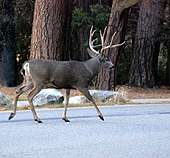
With its scrubby sun-baked chaparral, stately groves of pine, fir, and sequoia, and expanses of alpine woodlands and meadows, Yosemite National Park preserves a Sierra Nevada landscape as it prevailed before Euro-American settlement.[71] In contrast to surrounding lands, which have been significantly altered by logging, the park still contains some 225,510 acres (91,260 ha) of old-growth forest.[72] Taken together, the park's varied habitats support over 250 species of vertebrates, which include fish, amphibians, reptiles, birds, and mammals.[73]
Much of Yosemite's western boundary has habitats dominated by mixed coniferous forests of ponderosa pine, sugar pine, incense cedar, white fir, Douglas fir, and a few stands of giant sequoia, interspersed by areas of black oak and canyon live oak. A relatively high diversity of wildlife species is supported by these habitats, because of relatively mild, lower-elevation climate and the mixture of habitat types and plant species. Wildlife species typically found in these habitats include black bear, coyote, raccoon, mountain kingsnake, Gilbert's skink, white-headed woodpecker, bobcat, river otter, gray fox, red fox, brown creeper, two species of skunk, cougar, spotted owl, and a wide variety of bat species.[73]
Going higher in elevation, the coniferous forests become purer stands of red fir, western white pine, Jeffrey pine, lodgepole pine, and the occasional foxtail pine. Fewer wildlife species tend to be found in these habitats, because of their higher elevation and lower complexity. Species likely to be found include golden-mantled ground squirrel, chickaree, fisher, Steller's jay, hermit thrush, and northern goshawk. Reptiles are not common, but include rubber boa, western fence lizard, and northern alligator lizard.[73]
As the landscape rises, trees become smaller and more sparse, with stands broken by areas of exposed granite. These include lodgepole pine, whitebark pine, and mountain hemlock that, at highest elevations, give way to vast expanses of granite as treeline is reached. The climate in these habitats is harsh and the growing season is short, but species such as pika, yellow-bellied marmot, white-tailed jackrabbit, Clark's nutcracker, and black rosy finch are adapted to these conditions. Also, the treeless alpine habitats are the areas favored by Sierra Nevada bighorn sheep. This species, however, is now found in the Yosemite area only around Tioga Pass, where a small, reintroduced population exists.[73]
At a variety of elevations, meadows provide important, productive habitat for wildlife. Animals come to feed on the green grasses and use the flowing and standing water found in many meadows. Predators, in turn, are attracted to these areas. The interface between meadow and forest is also favored by many animal species because of the proximity of open areas for foraging and cover for protection. Species that are highly dependent upon meadow habitat include great grey owl, willow flycatcher, Yosemite toad, and mountain beaver.[73]
Management issues

The black bears of Yosemite were once famous for breaking into parked cars to steal food. They were also an encouraged tourist sight for many years at the park's garbage dumps, where bears congregated to eat park visitors' garbage and tourists gathered to photograph the bears. Increasing encounters between bears and humans and increasing damage to property led to an aggressive campaign to discourage bears from relying on human food or interacting with people and their property. The open-air dumps were closed; all trash receptacles were replaced with bear-proof receptacles; all campgrounds were equipped with bear-proof food lockers so that people would not leave food in their vehicles, which were easy targets for the powerful and resourceful bears. Because bears who show aggression towards people usually are eventually destroyed, park personnel have continued to come up with innovative ways to have bears associate humans and their property with unpleasant experiences, such as being hit with rubber bullets. Today, about 30 bears a year are captured and ear-tagged and their DNA is sampled so that, when bear damage occurs, rangers can ascertain which bear is causing the problem.[74]
Despite the richness of high-quality habitats in Yosemite, the brown bear, California condor, and least Bell's vireo have become extinct in the park within historical time,[75] and another 37 species currently have special status under either California or federal endangered species legislation. The most serious current threats to Yosemite's wildlife and the ecosystems they occupy include loss of a natural fire regime, exotic species, air pollution, habitat fragmentation, and climate change. On a more local basis, factors such as road kills and the availability of human food have affected some wildlife species.
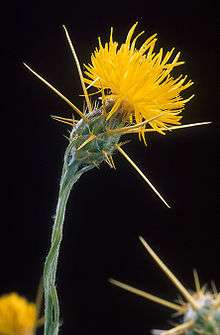
Yosemite National Park has documented more than 130 non-native plant species within park boundaries. These non-native plants were introduced into Yosemite following the migration of early Euro-American settlers in the late 1850s. Natural and human-caused disturbances, such as wildland fires and construction activities, have contributed to a rapid increase in the spread of non-native plants. A number of these species aggressively invade and displace the native plant communities, resulting in impacts on the park's resources. Non-native plants can bring about significant changes in park ecosystems by altering the native plant communities and the processes that support them. Some non-native species may cause an increase in the fire frequency of an area or increase the available nitrogen in the soil that may allow more non-native plants to become established. Many non-native species, such as yellow star thistle (Centaurea solstitialis), are able to produce a long tap root that allows them to out-compete the native plants for available water.[76]
Bull thistle (Cirsium vulgare), common mullein (Verbascum thapsus), and Klamath weed (Hypericum perforatum) have been identified as noxious pests in Yosemite since the 1940s. Additional species that have been recognized more recently as aggressive and requiring control are yellow star thistle (Centaurea solstitialis), sweet clover (Melilot spp.), Himalayan blackberry (Rubus armeniacus), cut-leaved blackberry (Rubus laciniatus) and large periwinkle (Vinca major).[76]
Increasing ozone pollution is causing tissue damage to the massive giant sequoia trees in the park, making them more vulnerable to insect infestation and disease. Since the cones of these trees require fire-touched soil to germinate, historic fire suppression has reduced these trees' ability to reproduce. The current policy of setting prescribed fires is expected to help the germination issue.
Wildfires
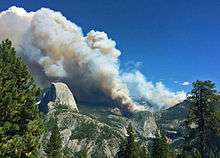
Forest fires seasonally clear the park of dead vegetation, making way for new growth.[77] These fires damage the income generated by tourism. The Rim Fire in 2013 destroyed nearly $2 billion in assets and revenue, though natural woodland assets are renewable, and closed off much of the park to tourists.[78] This fire was the third largest on record, and burned nearly 500 acres of wild habitat.[78]
During late July and early August, 2018, sections of the park, including the Valley, were temporarily closed due to the Ferguson Fire at its western boundary.[79] The closing was the largest in almost thirty years at the park.[80]
Activities

Yosemite Valley is open year-round and numerous activities are available through the National Park Service, Yosemite Conservancy, and Aramark at Yosemite, including nature walks, photography and art classes, stargazing programs, tours, bike rentals, rafting, mule and horseback rides, and rock climbing classes. Many people enjoy short walks and longer hikes to waterfalls in Yosemite Valley, or walks among giant sequoias in the Mariposa, Tuolumne, or Merced Groves. Others like to drive or take a tour bus to Glacier Point (summer–fall) to see views of Yosemite Valley and the high country, or drive along the scenic Tioga Road to Tuolumne Meadows (May–October) and go for a walk or hike.
Most park visitors stay just for the day, and visit only those locations within Yosemite Valley that are easily accessible by automobile. There is a US$25–30 per automobile user fee to enter the park, depending on the season.[81] Traffic congestion in the valley is a serious problem during peak season, in summer. A free shuttle bus system operates year-round in the valley, and park rangers encourage people to use this system since parking within the valley during the summer is often nearly impossible to find.[82] Transit options are available from Fresno and Merced.[83]
In addition to exploring the natural features of the park, visitors can also learn about the natural and cultural history of Yosemite Valley at a number of facilities in the valley: the Yosemite Valley Visitor Center, the adjoining Yosemite Museum, and the Nature Center at Happy Isles. There are also two National Historic Landmarks: the Sierra Club's LeConte Memorial Lodge (Yosemite's first public visitor center), and the Ahwahnee Hotel. Camp 4 was added to the National Register of Historic Places in 2003.[84]
In the winter, it is snowed in, but the area of Tuolumne Meadows has a great deal of hiking, rock climbing, and mountain climbing; see also the highest mountains of Yosemite National Park.
Hiking
.jpg)
Over 800 miles (1,300 km) of trails are available to hikers[7]—everything from an easy stroll to a challenging mountain hike, or an overnight backpack trip. One of the most popular trails leads to the summit of Half Dome and requires an advance permit from Memorial Day weekend in late May, to Columbus Day in early October.[85] A maximum of 300 hikers, selected by lottery, are permitted to advance beyond the base of the subdome each day, including 225 day hikers and 75 backpackers.[86]
The park can be divided into five sections for the day-user—Yosemite Valley, Wawona/Mariposa Grove/Glacier Point, Tuolumne Meadows, Hetch Hetchy, and Crane Flat/White Wolf.[87] Numerous books describe park trails, and free information is available from the National Park Service in Yosemite. Park rangers encourage visitors to experience portions of the park in addition to Yosemite Valley.
Between late spring and early fall, much of the park can be accessed for multiple-day backpacking trips. All overnight trips into the back country require a wilderness permit[88] and most require approved bear-resistant food storage.[89]
Driving destinations
While some locations in Yosemite require hiking, other locations can be reached via automobile transportation. Driving locations also allow guests to observe the night sky in locations other than their campsite or lodge. All of the roads in Yosemite are scenic, but the most famous is the Tioga Road, typically open from late May or early June through November.[90]
As an alternative to driving, bicycles are allowed on the roads. However, bicycles are allowed off-road on only 12 miles (19 km) of paved trails in Yosemite Valley itself; mountain biking is not allowed.[91]
Climbing
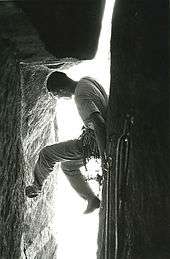
Rock climbing is an important part of Yosemite.[92] In particular Yosemite Valley, which is surrounded by famous summits like Half Dome and El Capitan. Camp 4, a walk-in campground in the Valley, was instrumental in the development of rock climbing as a sport, and is listed on the National Register of Historic Places.[93] Climbers can generally be spotted in the snow-free months on anything from ten-foot-high (3 m) boulders to the 3,300-foot (1.0 km) face of El Capitan. Classes on rock climbing are offered by numerous groups.
Winter activities
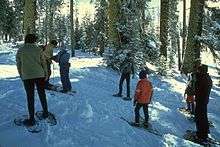
Yosemite Valley is open all year, although some roads within the park close in winter. Downhill skiing is available at the Badger Pass Ski Area—the oldest downhill skiing area in California, offering downhill skiing from mid-December through early April.[94] Much of the park is open to cross-country skiing and snowshoeing, with several backcountry ski huts open for use.[95][96] Wilderness permits are required for backcountry overnight ski trips.[88]
The Bracebridge dinner is an annual holiday event, held since 1927 at the Ahwahnee Hotel, inspired by Washington Irving's descriptions of Squire Bracebridge and English Christmas traditions of the 18th century in his Sketch Book. Between 1929 and 1973, the show was organized by Ansel Adams.[97]
Other
Bicycle rentals are available in Yosemite Valley spring through fall. Over 12 miles (19 km) of paved bike paths are available in Yosemite Valley. In addition, bicyclists can ride on regular roads. Helmets are required by law for children under 18 years of age. Off-trail riding and mountain biking are not permitted in Yosemite National Park.[98]
Water activities are plentiful during warmer months. Rafting can be done through the Yosemite Valley on the Merced River. There are also swimming pools available at Yosemite Lodge and Curry Village.
In 2010, Yosemite National Park was honored with its own quarter under the America the Beautiful Quarters program.[99]
In popular culture
The opening scenes of Star Trek V: The Final Frontier (1989) were filmed in Yosemite National Park. Films such as The Last of the Mohicans (1920) and Maverick (1994) have also been shot here.[100]
See also
- African-American Heritage Sites
- Bibliography of the Sierra Nevada
- Buffalo Soldiers (park rangers)
- Cathedral Peak Granodiorite
- Chinquapin, California
- Landslide of 1996
- List of birds of Yosemite National Park
- List of plants of the Sierra Nevada
- List of national parks of the United States
- Mark Daniels
- National Register of Historic Places listings in Yosemite National Park
- Protected areas of the Sierra Nevada
- Yosemite Sam
- Yosemite West, California, a community inside the gates of YNP
Citations
- "Yosemite National Park". Geographic Names Information System. United States Geological Survey.
- "Park Statistics". Yosemite National Park (U.S. National Park Service). Retrieved July 22, 2018.
- "Annual Visitation Highlights". nps.gov. National Park Service. Retrieved July 8, 2020.
- "the definition of yosemite". www.dictionary.com.
- Harris 1998, p. 324
- "Discover the High Sierra". California Office of Tourism.
- "Nature & History". United States National Park Service: Yosemite National Park. October 13, 2006. Archived from the original on January 25, 2007. Retrieved January 27, 2007.
- "Yosemite Wilderness". United States National Park Service: Yosemite National Park. Retrieved March 15, 2008.
- "Annual Park Recreation Visitation (1904 – Last Calendar Year)". U.S. National Park Service. Retrieved March 11, 2019.
- "New visitation record in 2016 as over 5 million people visited Yosemite National Park". GoldRushCam.com. Sierra Sun Times. Retrieved February 8, 2017.
- "History & Culture". United States National Park Service: Yosemite National Park. Retrieved January 27, 2007.
- Beeler, Dan Anderson, Madison S. "Origin of the Word Yosemite – What does Yosemite mean? Naming Yosemite Etymology: where did the place name Yosemite come from?". www.yosemite.ca.us. Retrieved October 4, 2015.
- NPS contributors (1989). Yosemite: Official National Park Service Handbook. no. 138. Washington, DC: National Park Service. p. 102.
- Runte, Alfred (1990). Yosemite: The Embattled Wilderness. University of Nebraska Press. pp. Chapter 1. ISBN 0-8032-3894-0.
- Greene 1987, p. 57.
- Schaffer, Jeffrey P. (April 29, 2002). "The Living Yosemite – The Ahwahnechee (One Hundred Hikes in Yosemite)". Great Outdoor Recreation Pages. Archived from the original on May 28, 2014. Retrieved May 27, 2014.
- Harris 1998, p. 326
- Bunnell, Lafayette H. (1892). "Chapter 17". Discovery of the Yosemite and the Indian War of 1851 Which Led to That Event. F.H. Revell. ISBN 0-939666-58-8. Archived from the original on October 5, 2012. Retrieved January 27, 2007.
- Anderson, Daniel E. (July 2016). "Origin of the Word Yosemite". The Yosemite Web. Retrieved April 14, 2020.
- "Yosemite". Online etymology dictionary. Retrieved September 10, 2010.
- Schaffer 1999, p. 46
- "Dispossessing the wilderness" (PDF). www.uky.edu.
- Wuerthner 1994, p. 20.
- Johns, J.S. (1996). "Discovery and Invention in the Yosemite". The Role of Railroads in Protecting, Promoting, and Selling Yellowstone and Yosemite National Parks. University of Virginia.
- NPS 1989, p. 58.
- Greene 1987, p. 360.
- Greene 1987, pp. 362, 364.
- Wuerthner 1994, p. 40.
- Greene 1987, p. 387.
- Huth, Hans (March 1948). "Yosemite: The Story of an Idea". Sierra Club Bulletin. Sierra Club (33): 63–76. Archived from the original on May 8, 2012. Retrieved April 20, 2011.
- Schaffer 1999, p. 48
- Sanger, George P., ed. (1866). "Thirty-Eighth Congress, Session I, Chap. 184 (June 30, 1864): An Act authorizing a Grant to the State of California of the "Yo-Semite Valley" and of the Land embracing the "Mariposa Big Tree Grove"" (PDF). The Statutes At Large, Treaties, and Proclamations of the United States of America from December 1863, to December 1865. 13. Boston: Little, Brown and Company. p. 325. Archived from the original (PDF) on November 16, 2011.
- Hutchings v. Low 82 U.S. 77 (1872)
- Ashburner v. California 103 U.S. 575 (1880)
- Runte, Alfred (1990). Yosemite : The Embattled Wilderness. Lincoln: University of Nebraska Press. ISBN 0-8032-8941-3.
- Schaffer 1999, p. 49
- "People – John Muir". The National Parks: America's Best Idea. PBS.
- Schaffer 1999, p. 50
- Schaffer 1999, p. 52
- NPS 1989, p. 117.
- "American Indians share their Yosemite story".
- Moseley, W. G. (2009). "Beyond Knee-Jerk Environmental Thinking: Teaching Geographic Perspectives on Conservation, Preservation and the Hetch Hetchy Valley Controversy". Journal of Geography in Higher Education. 33 (3): 433–451. doi:10.1080/03098260902982492.
- Schaffer 1999, p. 51
- "Badger Pass Ski Resort – Badger Pass –Badger Pass Yosemite". Destination360.com. Retrieved April 1, 2012.
- Furmansky, Dyana Z. (2009). Rosalie Edge, Hawk of Mercy: The Activist Who Saved Nature from the Conservationists. University of Georgia Press. ISBN 0-8203-3676-9.
- 98th U.S. Congress (1984). "California Wilderness Act of 1984" (PDF). Archived from the original (PDF) on February 3, 2012. Retrieved May 8, 2010.
- "A Student's Guide to Alternative Fuel Vehicles". EnergyQuest. California Energy Commission. Archived from the original on September 15, 2010. Retrieved September 10, 2010.
- National Park Service. "Ackerson Meadow Gifted to Yosemite National Park". Retrieved September 8, 2016.
- "Nature & Science". United States National Park Service: Yosemite National Park. Retrieved January 27, 2007.
- Harris 1998, p. 329
- "Geology: The Making of the Landscape". United States National Park Service: Yosemite National Park. December 22, 2004. Archived from the original on May 14, 2009. Retrieved January 27, 2007.
- "Geological Survey Professional Paper 160: Geologic History of the Yosemite Valley – The Sierra Block". United States Geological Survey. November 28, 2006. Archived from the original on October 22, 2012. Retrieved January 27, 2007.
- Harris 1998, p. 331
- Kiver & Harris 1999, p. 220
- Harris 1998, p. 332
- Harris 1998, p. 340
- Kiver & Harris 1999, p. 227
- "Water Overview". National Park Service: Yosemite National Park. December 22, 2004. Archived from the original on January 7, 2007. Retrieved January 27, 2007.
- "Hydrology and Watersheds". National Park Service: Yosemite National Park. December 22, 2004. Archived from the original on July 28, 2010. Retrieved January 27, 2007.
- "Wetland Vegetation". National Park Service: Yosemite National Park. December 22, 2004. Archived from the original on April 19, 2010. Retrieved January 27, 2007.
- Kiver & Harris 1999, p. 228
- Wuerthner 1994, p. 8
- "Climate". National Park Service: Yosemite National Park. December 22, 2004. Archived from the original on January 1, 2007. Retrieved January 27, 2007.
- "NOWData – NOAA Online Weather Data". National Oceanic and Atmospheric Administration. Retrieved June 9, 2013.
- "Yosemite Park HDQTRS, California". Western Regional Climate Center. Retrieved June 9, 2013.
- "Yosemite National Park, California, USA – Monthly weather forecast and Climate data". Weather Atlas. Retrieved January 26, 2019.
- Harris 1998, p. 328
- Harris 1998, p. 337
- Harris 1998, p. 339
- Harris 1998, p. 333
- Franklin, Jerry, F; Fites-Kaufmann, Jo Ann (1996). "21: Assessment of Late-Successional Forests of the Sierra Nevada". Sierra Nevada Ecosystem Project. Final Report to Congress. Status of the Sierra Nevada Volume II: Assessments and Scientific Basis for Management Options (PDF). pp. 627–671. ISBN 1-887673-01-6.
- Bolsinger, Charles L.; Waddell, Karen L. (1993). "Area of old-growth forests in California, Oregon, and Washington" (PDF). Resource Bulletin. United States Forest Service, Pacific Northwest Research Station (197). PNW-RB-197.
-

- "DNA to Help Identify "Problem" Bears at Yosemite". National Geographic. April 23, 2001. Retrieved January 4, 2007.
- Graber, David M. (1996). "25: Status of Terrestrial Vertebrates". Sierra Nevada Ecosystem Project. Final Report to Congress. Status of the Sierra Nevada Volume II: Assessments and Scientific Basis for Management Options (PDF). pp. 709–734. ISBN 1-887673-01-6.
- "Exotic Plants". National Park Service: Yosemite National Park. December 22, 2004. Archived from the original on January 2, 2007. Retrieved January 4, 2007.
- "Are There Good Forest Fires?". Evergreen Magazine. Summer 2002. Archived from the original on March 15, 2014. Retrieved March 14, 2014.
- "History of Wildland Fire in Yosemite Park". National Park Service. March 14, 2014. Archived from the original on February 7, 2015. Retrieved March 14, 2014.
- "Yosemite Valley will close due to fire. 'Get yourself out of here,' official says". fresnobee. Retrieved July 24, 2018.
- "Yosemite National Park Evacuated Amid Threat From Fire". Retrieved July 30, 2018.
- "Fees and Reservations". National Park Service: Yosemite National Park. Retrieved on October 27, 2007.
- "Bus". National Park Service: Yosemite National Park. May 27, 2009.
- Marshall, Aarian (May 24, 2019). "HIKING OR CAMPING? TAKE THE BUS TO THE TRAIL THIS SUMMER". Wired. Retrieved June 9, 2019.
- "Camp 4 Listed With National Register of Historic Places". NPS Press Release. National Park Service. February 27, 2003. Archived from the original on March 16, 2007. Retrieved December 14, 2008.
- "Half Dome Day Hike" (archive). nps.gov. National Park Service. April 18, 2018. Retrieved November 27, 2018.
- "Half Dome Permits for Day Hikers" (archive). nps.gov. National Park Service. November 9, 2018. Retrieved November 27, 2018.
- Cary, Russ. "Yosemite Hikes".
- "Wilderness Permits". National Park Service: Yosemite National Park. February 12, 2010.
- "Bear and food storage". National Park Service: National Park Service. February 10, 2010.
- "Auto Touring". National Park Service: Yosemite National Park. December 22, 2004. Retrieved January 27, 2007.
- "Biking". National Park Service: Yosemite National Park. March 2007. Retrieved March 23, 2007.
- "Climbing". National Park Service: Yosemite National Park. December 11, 2008.
- "Camp 4 Listed With National Register of Historic Places" (Press release). National Park Service: Yosemite National Park. February 27, 2003. Archived from the original on March 16, 2007. Retrieved January 27, 2007.
- "Skiing". National Park Service: Yosemite National Park. September 21, 2006. Retrieved January 27, 2007.
- "Tuolumne Meadows Winter Conditions Update". National Park Service: Yosemite National Park. Retrieved January 27, 2007.
- "Winter Wilderness Travel". National Park Service: Yosemite National Park. March 2, 2010.
- "History". The Bracebridge Dinner at Yosemite. Archived from the original on March 12, 2012. Retrieved May 8, 2010.
- "Plan Your Visit". Yosemite National Park. U.S. National Park Service. Archived from the original on February 21, 2009.
- "Yosemite National Parks Quarter". U.S. Mint. Archived from the original on July 21, 2011.
- Maddrey, Joseph (2016). The Quick, the Dead and the Revived: The Many Lives of the Western Film. McFarland. Page 175. ISBN 9781476625492.
General references
- Greene, Linda Wedel (1987). Yosemite: the Park and its Resources (PDF). U.S. Department of the Interior / National Park Service. Archived from the original (PDF) on June 6, 2011.CS1 maint: ref=harv (link)
- Harris, Ann G. (1998). Geology of National Parks (Fifth ed.). Kendall, Iowa: Hunt Publishing. ISBN 0-7872-5353-7.CS1 maint: ref=harv (link)
- Kiver, Eugene P.; Harris, David V. (1999). Geology of U.S. Parklands (Fifth ed.). New York: John Wiley & Sons. ISBN 0-471-33218-6.CS1 maint: ref=harv (link)
- Muir, John. "Features of the Proposed Yosemite National Park" The Century; a popular quarterly (Sept. 1890) 40#5
- Schaffer, Jeffrey P. (1999). Yosemite National Park: A Natural History Guide to Yosemite and Its Trails. Berkeley: Wilderness Press. ISBN 0-89997-244-6.CS1 maint: ref=harv (link)
- Wuerthner, George (1994). Yosemite: A Visitor's Companion. Stackpole Books. ISBN 0-8117-2598-7.CS1 maint: ref=harv (link)
- Yosemite: Official National Park Service Handbook. 138. Division of Publications, National Park Service. 1989.

- "Climate". National Park Service. December 22, 2004. Archived from the original on January 1, 2007. Retrieved January 27, 2007.
- "Exotic Vegetation". National Park Service. December 22, 2004. Archived from the original on January 2, 2007. Retrieved January 27, 2007.
- "Nature & History". National Park Service. October 13, 2006. Archived from the original on January 25, 2007. Retrieved January 27, 2007.
- "Water Overview". National Park Service. December 22, 2004. Archived from the original on January 7, 2007. Retrieved January 27, 2007.
- "Wildlife Overview". National Park Service. December 22, 2004. Archived from the original on January 27, 2007. Retrieved January 27, 2007.
External links
- Official website

- The Yosemite Conservancy
- The Role of the Railroads in Yellowstone and Yosemite National Parks from American Studies at the University of Virginia
- Yosemite Mariposa County Tourism Bureau
- Media specific
- Project Yosemite | Yosemite HD | Motion Timelapse Video
- "Historic Yosemite Indian Chiefs – with photos". Archived from the original on May 21, 2006. Retrieved April 6, 2019.
- Historic Photographs of Yosemite National Park taken by Edith Irvine
- Project Yosemite | An ongoing adventure to timelapse Yosemite in an extreme way
- My First Summer in the Sierra by John Muir. Free MP3 audio recording from LibriVox.org
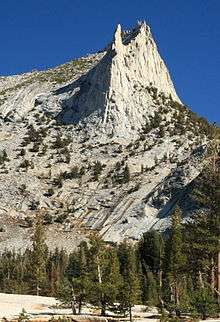
%2C_Yosemite_NP_-_Diliff.jpg)


